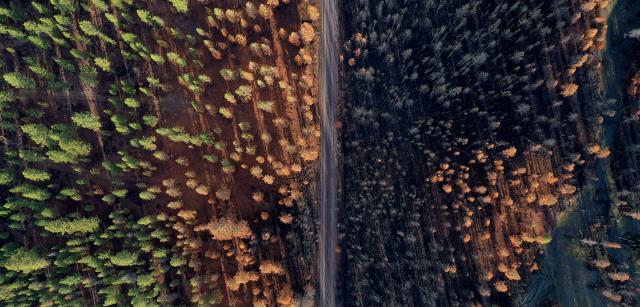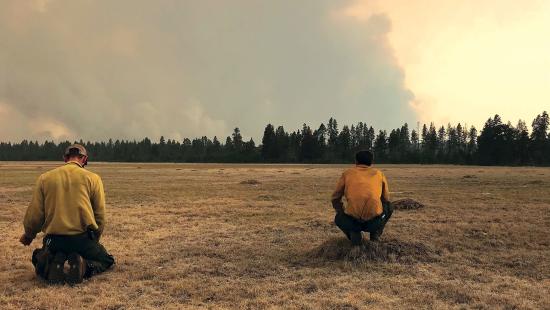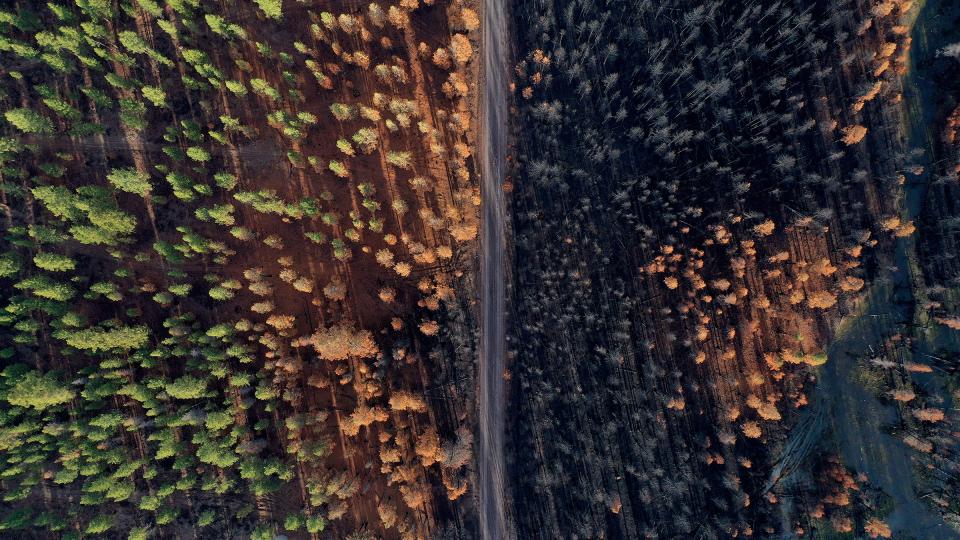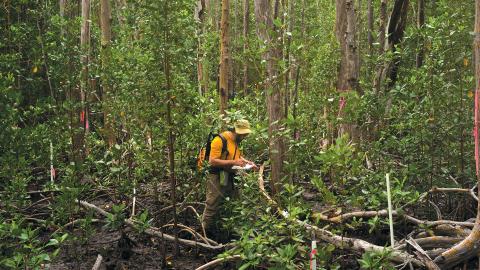

The power of dry forest restoration after the 2021 Bootleg Fire in Oregon’s Sycan Marsh Preserve — resilient, healthy pines (left) and unrestored lands (right). Photo: Brady Holden
The Fire Paradox: A Threat, But Part of the Solution
YSE alumni are combining innovative forest restoration treatments with traditional land management methods to make ecosystems more resilient to destructive wildfires.
The ponderosa pine is a survivor. The most widely distributed pine species in North America, stretching across the western part of the continent from British Columbia to parts of Mexico, Pinus ponderosa has distinctively thick and aromatic bark, large bright-green needles, and prickly cones. Many of them soar over 200 feet into the air — with tall, straight, thick trunks.
Like most flora, these adaptations are beneficial. The native lands of the ponderosa pine are also home to some of the most violent and destructive recent wildfires on our planet. In 2020 alone, 52,113 wildfires burned nearly 9 million acres of land, mainly in the U.S. West — roughly 2.3 million more acres than the 10-year average and almost double the acreage burned in 2019, according to the National Interagency Fire Center.
“Fire always has been a part of these landscapes. Beneficial fire — like prescribed burns and managed wildfires — is essential to the long-term resilience of these forest landscapes into the future.”
Frequent, low-intensity fires are, in fact, essential for ponderosa pine forests and other native plant and animal species, which have adapted over millennia to survive these conditions. Over time, ground fires have burned seedlings and saplings, accumulations of pine needles, and low branches, leading to low-density, open ponderosa pine forests with few “ladder fuels” to move fires into the canopies. Fire suppression efforts, however, have reversed this trend, leading to denser stands and high fuel conditions, creating a greater propensity for stand-replacing canopy fires in which few trees survive.
Pete Caligiuri ’10 MF knows this seems paradoxical. Raging wildfires destroy acres of forests, wipe communities off the map, pollute our skies, and put animals at risk of extinction. How can fire be good?
“Frequent, extreme wildfires are a threat, but fire has to be part of the solution,” says Caligiuri, the forest strategy director for The Nature Conservancy in Oregon. “Fire always has been a part of these landscapes. Beneficial fire — like prescribed burns and managed wildfires — is essential to the long-term resilience of these forest landscapes into the future.”

As the forest strategy director for The Nature Conservancy in Oregon, Pete Caligiuri ’10 MF helps oversee the Sycan Marsh Preserve, a “living laboratory” used to develop ecologically based restoration treatments that make ecosystems more resilient to fire. Photo: Brady Holden
But scaling up efforts to build resilient landscapes can take a long time; adaptation of species, considerably longer. Fueled in large part by our rapidly changing climate, fires are raging in places and during times of the year that are unprecedented, raising the urgency to understand the impacts increasing wildfires have on our ecosystems.
And, right now, it appears adaptation may be our best bet.
“Our human history is tied to our ability to use fire,” says Jennifer Balch ’08 PhD, associate professor of geography at the University of Colorado and director of the school’s Earth Lab. “It pervades our history, our evolution as a species. Many have forgotten how integral fire is to our human existence.”
“We can’t live without fire.”
Nearly two decades ago, Jennifer Balch was a PhD student at YSE who found herself deep in the Amazon rainforest. She was there to see what happens when you set it on fire.
Tropical rainforests do not traditionally burn, and the reason for that is right in the name. Moisture within the vegetation and the soil usually prevents any wildfires from starting or at least spreading. The fuel sources for wildfires we see in temperate forests or grasslands are usually not present.
But with drums already beating from the scientific community about the rapidly changing global climate, Balch was curious: What would happen if the Amazon burned?
Playing the role of “burn boss,” Balch led an unprecedented, experimental large-scale burn of 370 acres of forest and monitored the effects for a decade. “What we found was a closed-canopy tropical forest that turned into something vastly different,” Balch says.
At the edge of the burned area, there was “basically a grassland system,” she says. The canopy lost roughly 60% of its trees, opening a lane for native and invasive undergrowth to now thrive. Even the behavior of leaf-cutter ant colonies — which move leaf litter and other potential fuel sources — had changed.
In recent years, a combination of the changing climate and intentional burning for agricultural and mining purposes has created an exponential surge in fires in the Amazon. Brazil’s National Institute for Space Research reported that more than 39,000 fires were detected via satellite in the Amazon in 2019, a 77% increase from the previous year. The world’s most critical ecosystem, essential for the natural capture of global carbon emissions, was engulfed in flames — and the world was beginning to take notice.
“The science community needs to step it up; we need to stop documenting the problem and start the rallying cry. Everyone needs to do their part to get ahead of this.”
“Ecosystems are already changing,” says Balch. “Humans are changing the climate and the landscapes, and we’re seeing increased fire as a result. We’re providing the ignition, with invasive vegetation doubling and tripling the amount of fire.”
Today Balch focuses her research closer to home, in the American West. In a recently published paper in the journal Nature, she outlines the rise in nighttime fire intensity, signaling hotter temperatures at night than during the day. This, she says, means fires are passing from day to night, losing breaks in fire intensity that are critical for those fighting wildfires.
Six years ago, Balch established Earth Lab at the University of Colorado, a data synthesis center that applies analytics to Earth systems data to make new breakthroughs and help society adapt to the changing world. A major initiative of the lab focuses on environmental extremes and natural hazards, particularly how fire regimes are changing in the U.S. Researchers are studying changes in fire seasons, the proportion of fires that are started by humans versus natural causes, the conditions in which fires occur across the U.S., and if there are predictors for large fire events.
Their work is being quickly put to the test. In 2021, a wetter than normal spring led to above-average grass growth in Boulder County, Colorado; a warm and dry summer and fall, coupled with high winds, created the perfect conditions for a wildfire. The resulting Marshall Fire in early 2022 burned more than 6,000 acres and destroyed more than 1,000 buildings.
“Fires shouldn’t be burning in the winter,” says Balch, who has seen people close to her lose their homes to the fires. “I’ve only seen snow put out a fire once before this year — and that was last year. It just makes me ask, ‘What is going on here?’”
Balch and Earth Lab are using their experiences to sound the alarm, sharing knowledge and tools with other communities about how to make ecosystems more resilient to wildfire. She says that while there is space for “good fire,” there are more than a million homes within wildfire areas in the U.S. and more than 59 million more within one kilometer of these spaces. Balch believes that new measures introduced by the federal government, including prescribed burns and fuel mitigation, have the potential to help, but she stresses the need to create more science-informed solutions.
“There is so much at stake,” Balch says. “The science community needs to step it up; we need to stop documenting the problem and start the rallying cry. Everyone needs to do their part to get ahead of this.”
Pete Caligiuri has also had his close calls with wildfires. Located in the arid landscapes of central and southern Oregon, not far from where he grew up in Bend, he has spent a decade with The Nature Conservancy working on dry forest restoration.
“This area has all the necessary ingredients for fire,” says Caligiuri. Last year, those ingredients cooked up the devastating Bootleg Fire, which burned more than 413,000 acres of land across south central Oregon, requiring more than 2,000 firefighters to quell the blaze. It was the second largest wildfire in the U.S. in 2021, leading to poor air quality conditions as far away as New England.
The enormous fire created a real-life test for Caligiuri and his TNC colleagues, who oversee the Sycan Marsh Preserve, a 30,000-acre property in south central Oregon that features a diverse range of high-elevation marsh and dry forest habitats as well as countless ponderosa pines. The preserve is used as a “living laboratory,” allowing researchers to conduct ecologically based restoration treatments to create a more resilient ecosystem. Many of the strategies used are developed and implemented in partnership with the local Klamath Tribes, who have stewarded this sacred land for centuries.

The Bootleg Fire burned more than 413,000 acres of land across south central Oregon in summer 2021, requiring more than 2,000 firefighters to battle the blaze. Photo: courtesy of The Nature Conservancy
“As the Bootleg Fire started and we saw it was headed toward the preserve, we realized we were about to learn something,” Caligiuri says. And what they have learned so far is promising: “Reintroducing fire is very important. Even under the very extreme conditions of the Bootleg Fire, we see that the reintroduction of lower-intensity fires — similar to those that have historically burned through this area — has had significant positive impact on the forest. In those places where we have successfully reintroduced fire, the forest is green and still providing habitat and ecosystem benefits.”
“It was a wakeup call,” he adds. “The scale of the work we’re doing on the preserve is relatively small, and we really need to increase the scale and pace of ecological restoration. The people who need these lands — the tribes, local communities, all of the stakeholders — are depending on us getting to a larger scale. And part of it is learning to live with fire: managing fire under milder conditions to achieve the ecological and cultural benefits when and where it’s possible and containing and suppressing fire when needed to protect lives and communities.”
While climate change is indeed a cause for the increase in wildfires, Caligiuri points to a history of unsustainable forest management in the western U.S. for laying the groundwork for the current situation. This began, he says, with the forced removal of Indigenous peoples, followed by the introduction of domestic livestock that ate the native, grassy understories that served as a “conveyor belt for fire,” and the subsequent widespread logging of the fire-tolerant ponderosa pines. He also argues that the U.S. Forest Service’s interest in fighting lower-intensity fires throughout the 20th century has resulted in less “good fire” and created a much different landscape — dense forests full of small trees and undergrowth.
“Fire in the area was once a self-regulating process in these forests,” Caligiuri says, relying on both scientific research and Indigenous knowledge. “Now, in the unhealthy condition these dry forests are in today, we’re just waiting for the next lightning bolt or careless person to spark the next wildfire.”
Like most of the American West, much of Oregon’s 19 million acres of dry forests are under federal jurisdiction where renovation techniques are prohibited — and nearly 4 million of those acres need ecological restoration, according to TNC and the U.S. Forest Service. In response, the Sycan Marsh Preserve has become a place where researchers can test different ecological restoration treatments in hopes of creating more resilient dry forests in a way that is scalable across Oregon and the western U.S. Caligiuri says TNC’s goal is to create a base for fundamental policy changes in forest and fire management needed to create resilient, adaptable landscapes in the face of climate change. He highlights positive change taking place, including new policy in Oregon that invests in community-level efforts and infrastructure as well as the new Infrastructure Investment and Jobs Act that has made billions of dollars available to support federal land management agencies to proactively address forest resilience and wildfires.
“It can’t be a business-as-usual approach,” he says. “We need to reexamine how we live in and around these landscapes and work together, across organizations and ownership boundaries, to restore them in a way that allows us to live more compatibly with fire.”
It is not only the western U.S. or the Amazon being affected by wildfires; vast swaths of Africa, Asia, and Europe have experienced devastating, costly fires in recent years. The Australian bushfires in 2019–2020, dubbed the “Black Summer,” claimed an estimated 60 million acres of land and dealt an unfathomable blow to the country’s unique biodiversity.
“It will be a long time … before the entire region recovers, before the forests that cover these landscapes recover,” Patrick Baker ’93 MF, a professor of silviculture and forest ecology at the University of Melbourne, told the Yale Daily News in January 2020.

Gracie Bachmann ’23 MF arrived at YSE with considerable experience with wildfires, previously having worked as a wildland firefighter in Colorado, Arizona, and Oregon. Photo: courtesy of Gracie Bachmann
Gracie Bachmann ’23 MF, who has worked as a wildland firefighter, has seen intense fires burn in Oregon, Arizona, and Colorado. Through internships and professional experience, she has also seen fires in Costa Rica, Ecuador, and Senegal.
“If you care about having clean water and clean air, you should care about fire. ... A burned forest is not just a scarred landscape. It affects you and the people you know. At some point or another, it will feel real for all of us.”
As a student, Bachmann is now one of the leaders of the Fire Student Interest Group, helping to lead programs for YSE students about fire ecology and land management. Her academic interests focus on understanding fire in tropical landscapes — much like Balch before her — but she also works closely with Matt Valido ’21 MF, forest manager of Yale School Forests, on fire in temperate forests. She has helped Valido create curriculum opportunities for students interested in wildfires and has led prescribed burns at Yale-Myers Forest.
All of this to say: Bachmann is fully invested in the future of fire on our landscape and the role it plays in our ecosystems.
Wildfires affect every corner of the globe. They change the world we live in — and have for millennia. That wildfires are more frequent and more intense is a global concern, but not one that cannot be handled with immediate and well-managed action. The clock, however, is ticking.
“If you care about having clean water and clean air, you should care about fire,” says Bachmann. “Fire alters how our forests grow, the flora and fauna that they support, and, from a carbon perspective, we need our forests. They also can regulate our weather. They provide recreation space.
“A burned forest is not just a scarred landscape. It affects you and the people you know. At some point or another, it will feel real for all of us.”



